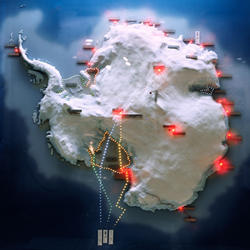|
Anne Noble is more than a photographer of the Antarctic: she is
discoverer of the visual history of the Ice. Noble has been on the
trail of the last continent from the vantage point of New Zealand for
some years now, and visited the Ice (as the New Zealanders call Antarctica)
on a tourist ship and as part of the NZ Antarctic program. As Gender
On Ice is published, Noble is the guest of the U.S. National Science
Foundation Artists and Writers Program, photographing the ever-shifting
ice.
Antarctica, to Anne Noble, begins in the imagination. Its medium has
been photography. As Noble states, ". . . our sense of the Antarctic comes
from the long tradition of 'heroic' photography . . . from wilderness
and tourism photography and museum displays. . . that reinforce images
we have already seen." For Noble this means that much of her Antarctic
photography takes place in sites off-continent, in tourist cruise ships,
museum installations, historic artifacts, traveling exhibits and
family-style entertainments such as "Kelly Tarleton's Antarctic
Experience," a well-known tourist attraction in Auckland, NZ, where live
penguins on display vie with life size recreations of the interior of
Scott's hut, down to the detail of the contents of the explorers'
bookshelves. Noble questions the formulaic power of Heroic Age
representation in re-photography. In her notorious rephotographing of
the Scottish 1902-04 national expedition's well-known image, "The Piper
and the Penguin," the kilted bagpiper still screams Scotsman on ice, and
the penguin, not so subtly tethered to a tambour, remains the Scotsman's
captive audience, now through layers of time and irony. Noble is
herself an Antarctic curator in the broadest sense, providing a cultural
history of Antarctic representation through her own substantial body of
work, as well as her editorial work in the 2007 special issue on
Antarctica of New Zealand Journal of Photography.
This engagement with how Antarctica is imaged, produced, and
circulated characterizes Noble's recent work. In 2006 Noble created a
suite of images and artifacts displayed at a New Zealand gallery that
played with both the commodification of Antarctica and the art market in
which her work on Antarctica inevitably takes on meaning and value, as
it circulates knowledge about the least capitalized place on earth.
Noble was inspired to create "Antarctic Shopping Party" when she came
across "mention of the organization Antarctic-Link, Canterbury. One of
their key objectives is to build a marketable Antarctic product-set for
Christchurch New Zealand, to help brand the city as a 'Gateway to
Antarctica . . .." Keeping in mind tourist shop creations such as
stuffed penguins and krill key rings, explorer logo mugs, T-shirts
and the like, Noble crafted consumables such as Antarctica shaped (iced)
cakes and cookies, a continent-shaped jigsaw puzzle, and CDs and video
tapes branded with the image of the continent—all for sale at the
gallery. Locked into the parody is a " . . . sadness . . . about the
desire and longing for that transcendental feeling of place and how it
becomes a thing we consume." As beautiful and enjoyable as Noble's
Antarctic objects may be for an audience, their appreciation is innately
linked to a sense of loss of the object of Antarctica, here so complexly
represented. In her "Whiteout" project, Noble engages another type of
loss, a visual one, as she points her lens mercilessly into Antarctic
icescapes that lack horizon, color fields, or any conventional markers
of place. Seeing Antarctica as Noble presents it in "Whiteout" becomes
as perilous an act as navigating the white expanse of the Ice.
The ways culture has created to know and to interact with Antarctica
is most simply seen in the map, an economic object that both represents
and circulates Antarctica. Anne writes of her map series: "This
collection of maps points to the way visual colonization of place occurs
as a part of the way that we map, photograph, organise, define, and
interpret place." Expanding on the idea that photography is complicit
in the evolution of an Antarctic economy, Noble finds maps in obvious
and strange places. Amid plastic blow up world maps and other casual
ephemera, a chilling reminder of early corporate involvement appears in
the British Petroleum map of Antarctica from 1955. Following up a lead
from her stay at New Zealand's Scott base, a nicely preserved set piece
from the 1950s, Noble discovered the map in the archives of the
Canterbury Museum in Christchurch, NZ. The BP map is shaped as a board
game and is an accidental witness to the foundational, and taken for
granted, influence of petrochemical corporations in the creation of
Antarctic place.
Noble's Antarctic vision is so varied and deeply thought that it
reminds us of a most important and overlooked fact: Antarctica is not a
single or unified place. It is not timeless, or an empty signifier for
sublimity, or a culturally neutral notion of grandeur. Noble is more
interested in the ways "grandeur plays out in an artificial environment"
both on the continent and in other locations. Noble has pieced together
a global "puzzle" of multiple, competing, and even incoherent
Antarcticas. This inexhaustible Antarctica ultimately has no sure
origin or foregone end. Noble's remapped representational histories
have profound implications for geopolitics: who owns this place, or even
its image?
Statement by Elena Glasberg. All quotes from: "A Landscape
Brought to Light." The Age. 13 September 2008.
|








